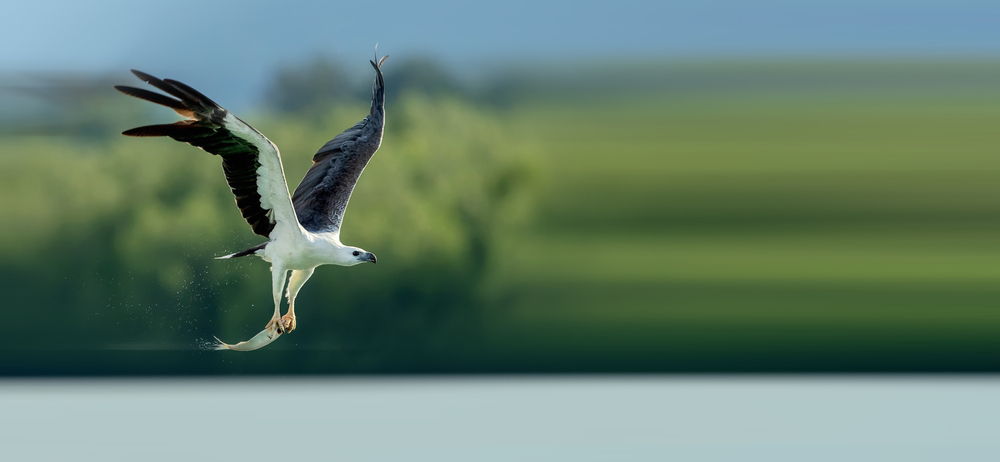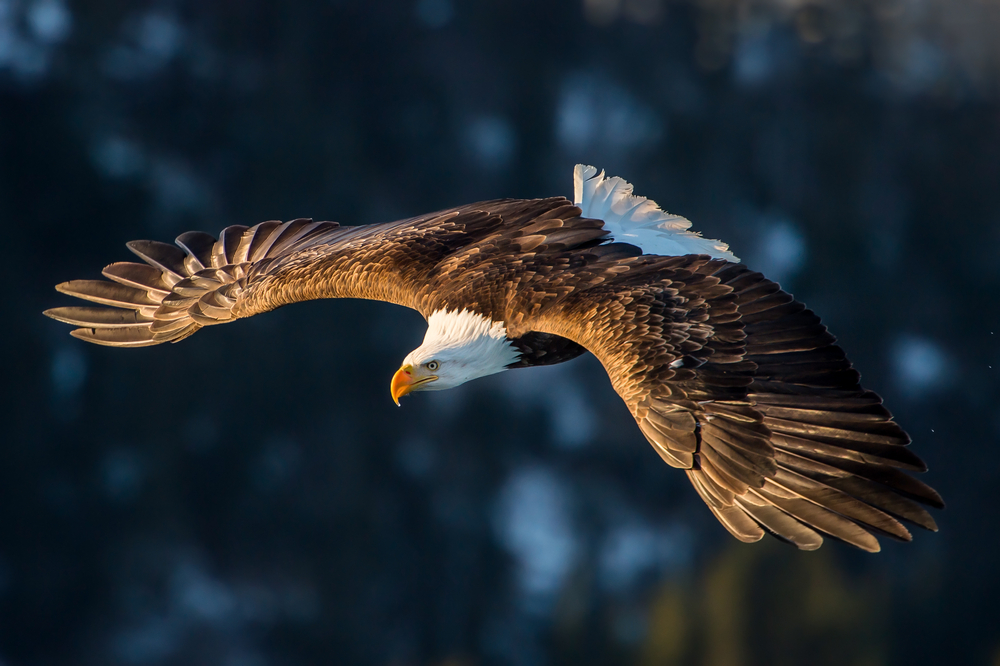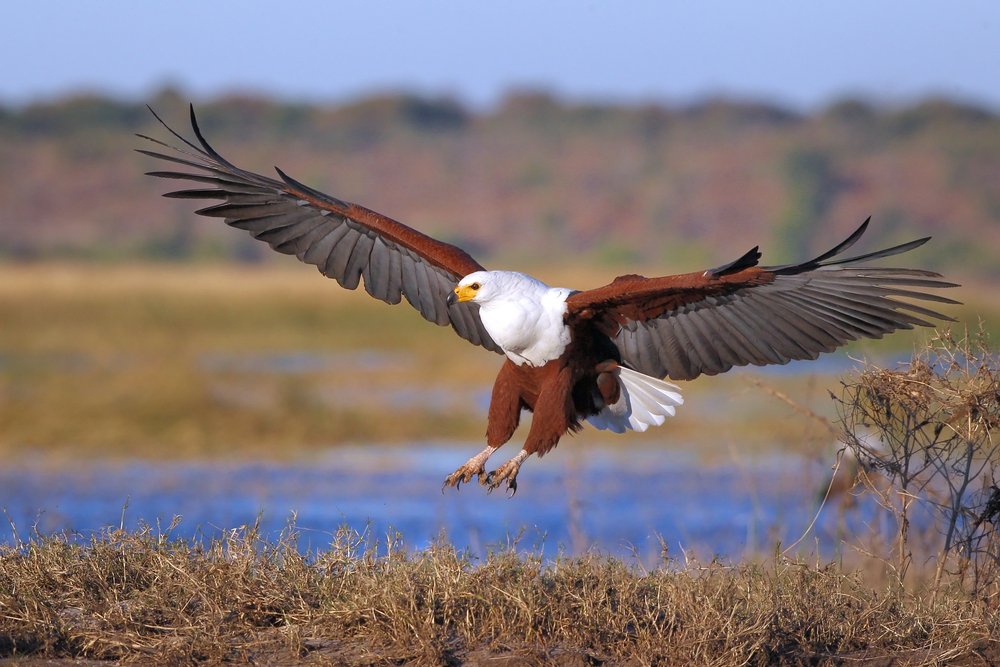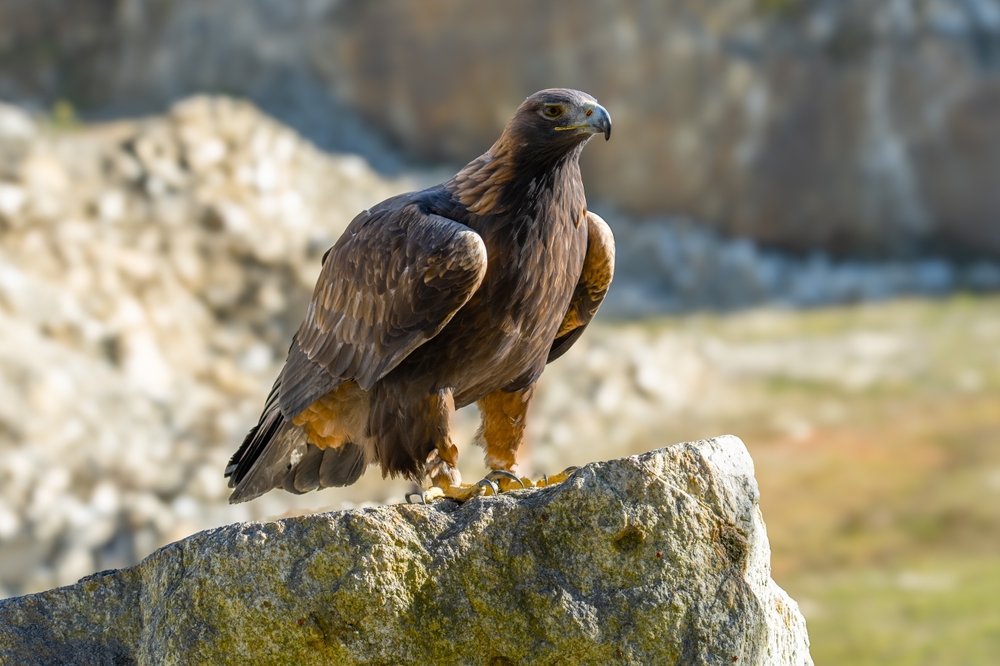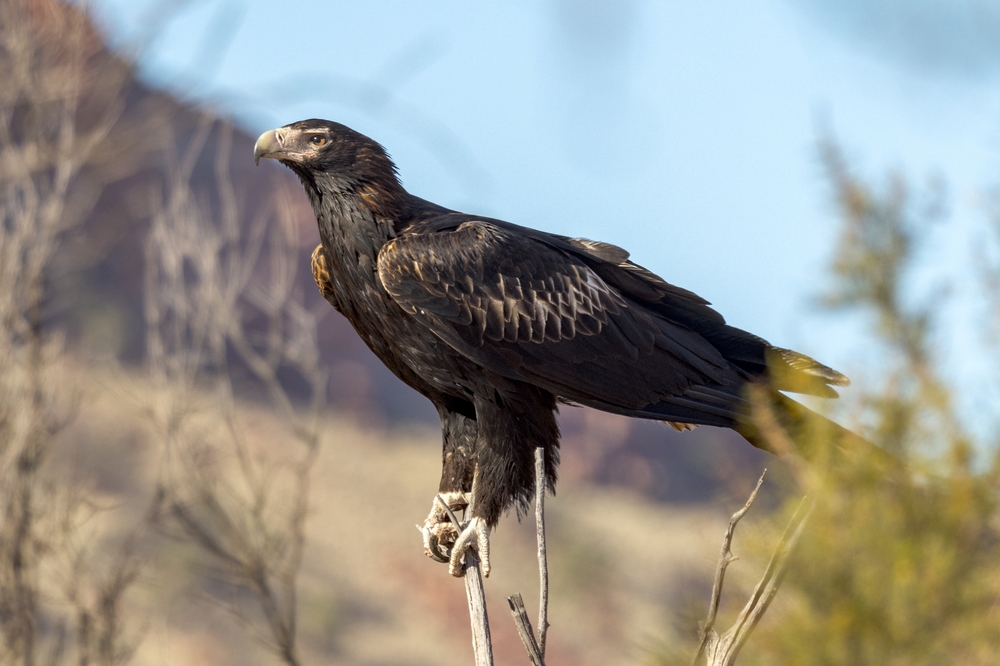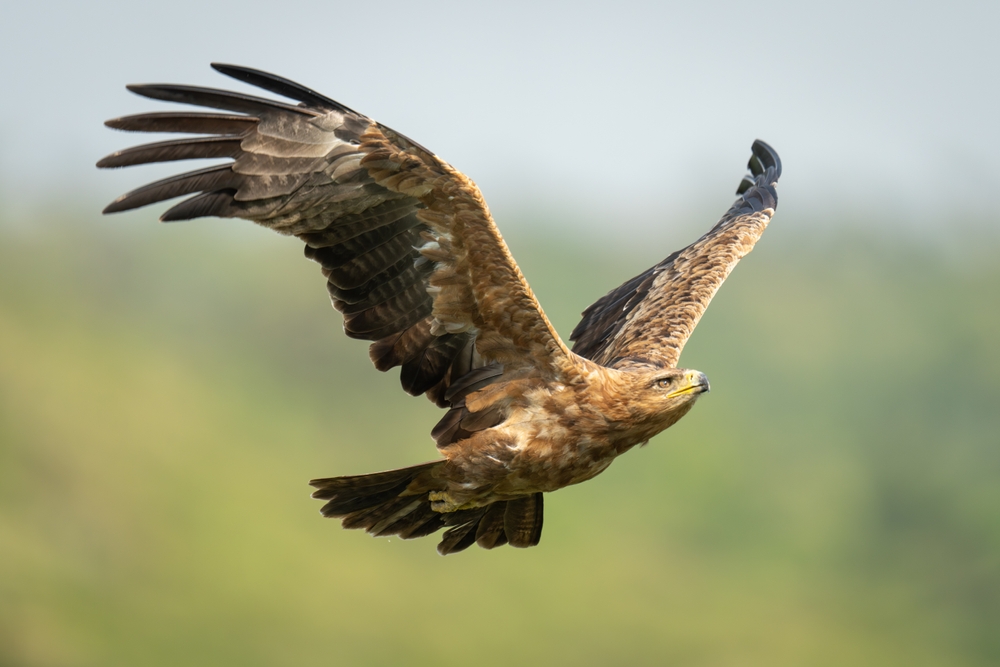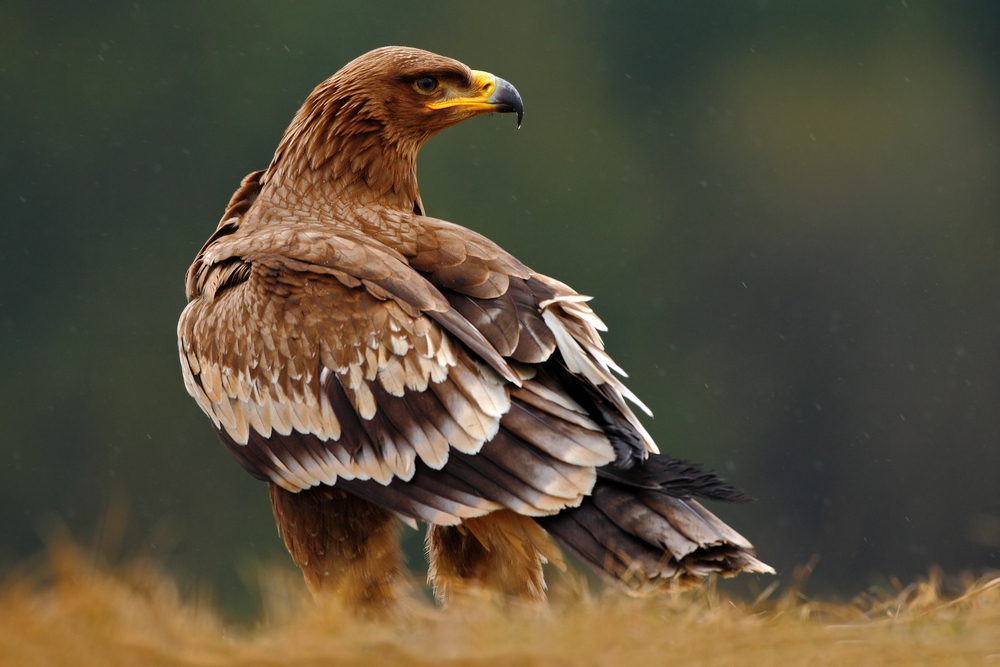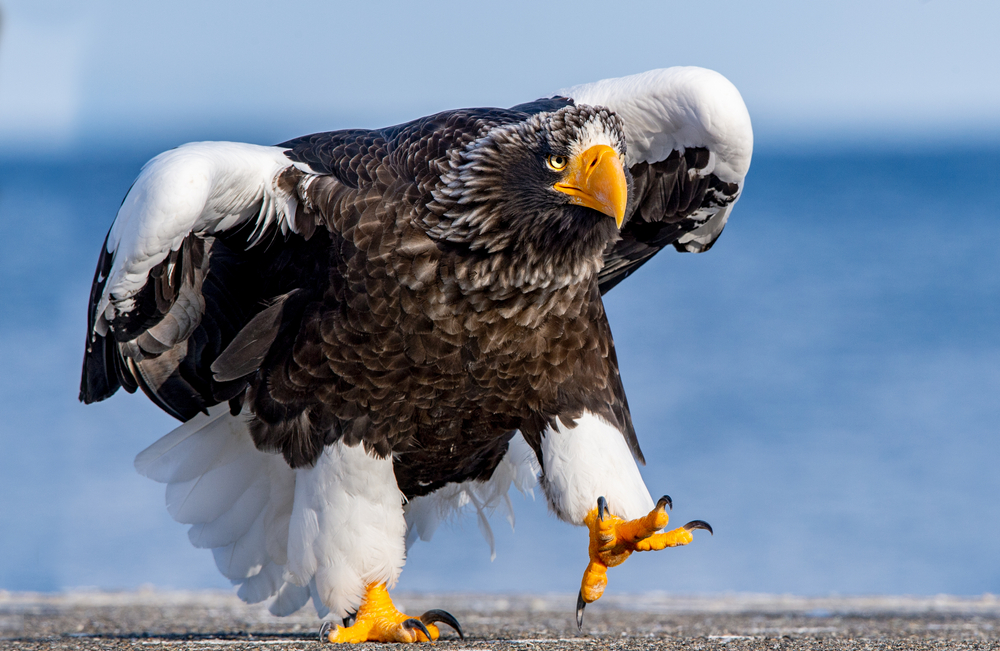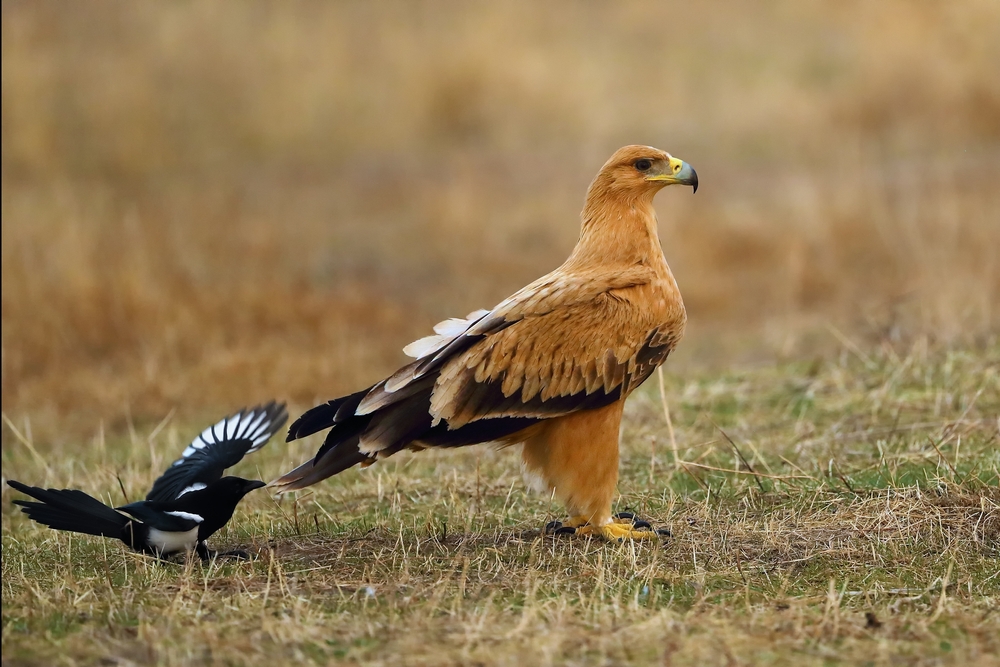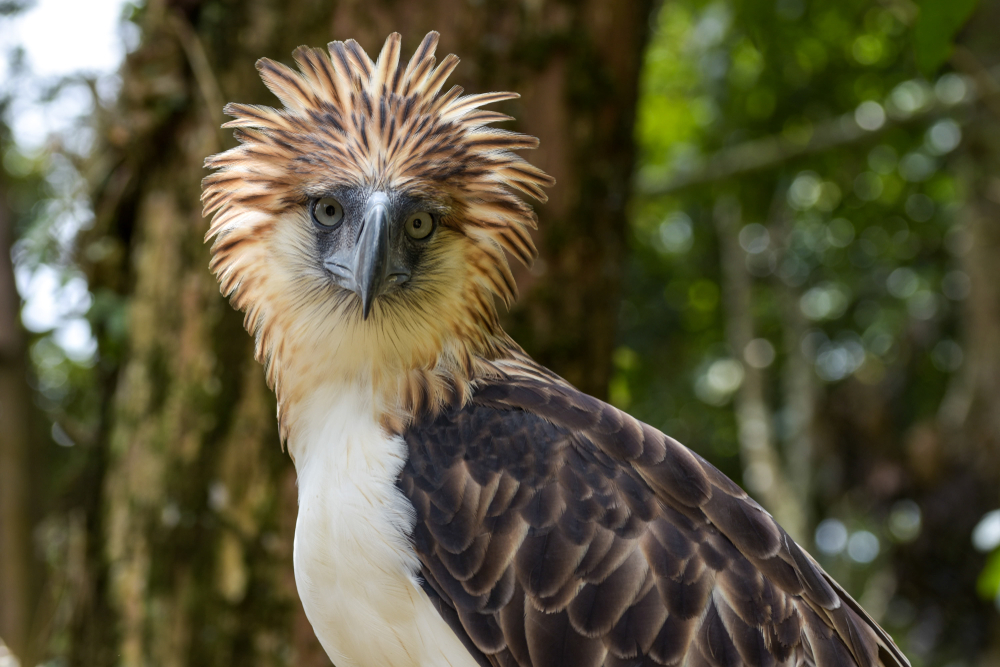Its closest relative is the Bald Eagle (Haliaeetus leucocephalus) and White-tailed Eagle (Haliaeetus albicilla), forming part of the sea eagle group within the genus Haliaeetus.
About
The White-bellied Sea Eagle (Haliaeetus leucogaster) is a large and striking bird of prey belonging to the Accipitridaefamily, the same group that includes hawks, kites, and other eagles. Widely distributed across coastal Asia and Australasia, it is one of the most recognizable raptors of the Indo-Pacific region. Its bold white head, underparts, and tail contrast with slate-grey wings and back, creating a distinctive silhouette in flight.
This eagle is impressive in size, with a wingspan of 1.8 to 2.2 meters (6 to 7.2 feet) and a body length ranging from 70 to 85 centimeters (28 to 33 inches). It is often seen soaring gracefully above coastlines, estuaries, and large inland lakes, where it hunts fish, waterbirds, and reptiles. Like other sea eagles, it is also an opportunistic feeder, readily taking carrion or robbing other birds such as ospreys.
The White-bellied Sea Eagle has an extensive range, found from India and Southeast Asia through Indonesia and Papua New Guinea, down to Australia and Tasmania. It plays an important role in many coastal ecosystems, helping regulate fish and bird populations and contributing as a scavenger. In Australia, it is particularly revered as a cultural symbol among Indigenous communities, where it features in folklore and traditional stories.
Nesting typically occurs in tall trees near water or occasionally on cliff edges. Pairs are monogamous and maintain territories year-round. Their nests, constructed of large sticks and lined with leaves, are used and expanded annually, sometimes growing to massive sizes over generations.
This species is generally secure across much of its range, though local populations face threats from habitat destruction, disturbance, and pollution. Its commanding presence, ecological importance, and cultural significance make the White-bellied Sea Eagle one of the most admired raptors of the Asia-Pacific.
Physical Characteristics
The White-bellied Sea Eagle is a large, striking raptor with bold coloration and powerful build:
Plumage: Adults have a distinctive appearance with a gleaming white head, breast, belly, and thighs. The upperparts, including the wings and back, are slate-gray, while the underwings show a dramatic contrast of white and dark flight feathers. The tail is short, wedge-shaped, and entirely white. Juveniles are mottled brown, gradually whitening as they mature over 4–5 years.
Head & Beak: The head is large and pale with a strong, hooked, bluish-gray beak tipped in black. The cere (base of the beak) and feet are yellow, while the eyes are a deep brown.
Body & Wings: The body is robust with very broad wings that taper at the tips. When soaring, they hold their wings in a slight dihedral (V-shape) and exhibit slow, steady wingbeats interspersed with glides.
Size:
-
Length (Body): 27–35 in (70–90 cm)
-
Wingspan: 5.9–7.4 ft (1.8–2.2 m)
-
Tail Length: 8–12 in (20–30 cm)
Weight:
-
Adult Female: 6.5–9 lbs (3–4.2 kg)
-
Adult Male: 4.5–6.5 lbs (2–3 kg)
The White-bellied Sea Eagle’s bold white underside, massive wingspan, and wedge-shaped white tail make it unmistakable in flight, and it is often considered one of the most beautiful eagles of the Asia-Pacific region.
Reproduction
The reproductive cycle of the White-bellied Sea Eagle reflects its life as a long-lived, territorial raptor:
1. Mating and Courtship:
White-bellied Sea Eagles are monogamous and usually pair for life. Courtship involves aerial displays, including soaring together, talon-grappling, and spectacular dives. Pairs often call in duet, reinforcing their pair bond.
2. Breeding Season:
The breeding season varies across their wide range, generally occurring in the dry season when prey is more predictable. In Australia, nesting often peaks between May and October.
3. Nesting:
Pairs construct massive stick nests high in tall trees near water or occasionally on cliffs. Nests can measure over 6 ft (2 m) across and are reused and enlarged over many years.
4. Egg Laying and Incubation:
The female typically lays 1–2 eggs, though occasionally 3. Eggs are dull white and rounded. Incubation lasts about 40–44 days, mostly by the female, while the male provides food.
5. Hatching and Chick Development:
Chicks hatch asynchronously, leading to size differences. In years of food shortage, usually only the stronger chick survives. Both parents feed and protect the young.
6. Fledging:
The young fledge at about 65–75 days but remain dependent on their parents for several weeks, gradually learning to fly and hunt.
7. Sexual Maturity:
They reach breeding age around 5–6 years, once their full adult plumage is acquired.
The White-bellied Sea Eagle’s reproductive strategy of low clutch size but high parental care ensures that even a single chick can be successfully raised in favorable years.
Lifespan
The White-bellied Sea Eagle is a long-lived bird of prey, with survival shaped by access to prey, habitat stability, and human pressures.
Lifespan in the Wild:
In natural conditions, White-bellied Sea Eagles live an average of 20 to 25 years. Many die young due to juvenile mortality, but adults that establish territories and avoid threats can survive for decades.
Lifespan in Captivity:
In captivity, individuals may live up to 30 years or more, benefitting from steady food supplies, veterinary care, and protection from accidents or persecution.
Threats to the White-bellied Sea Eagle:
-
Habitat Loss: Clearing of tall nesting trees near waterways reduces breeding opportunities.
-
Human Disturbance: Nesting pairs may abandon sites when exposed to frequent boat traffic or shoreline development.
-
Pollution: Bioaccumulation of toxins and overfishing can reduce prey availability and harm breeding success.
-
Persecution: In some regions, sea eagles have been historically shot or poisoned due to conflicts with fishermen.
Conservation Efforts:
The species is legally protected in most of its range, with healthy populations across coastal Australia and Southeast Asia. Preservation of wetlands, rivers, and coastal habitats remains essential for its long-term survival.
Eating Habits
The White-bellied Sea Eagle is a versatile predator and scavenger, strongly tied to aquatic habitats.
Diet:
Its diet consists mainly of fish and waterbirds, but it also takes reptiles, mammals, and carrion. Common prey include mullet, catfish, ducks, coots, turtles, and occasionally small kangaroos or wallabies. They are also known to steal fish from other birds such as ospreys and cormorants.
Hunting Strategy:
The eagle hunts by soaring high over coasts, rivers, and lakes, scanning for prey. It often swoops down to seize fish from the water surface with its talons or ambushes waterbirds resting near shorelines. It is less of a pursuit hunter and more reliant on power, surprise, and opportunism.
Scavenging Behavior:
White-bellied Sea Eagles frequently feed on carrion, including roadkills, beached fish, and livestock carcasses. This scavenging role helps recycle nutrients in coastal and river ecosystems.
Feeding Habits:
They use their strong beaks and talons to tear apart prey. A single large fish or bird can provide ample food for a pair or a growing chick. Parents carefully shred food into small portions for their nestlings.
Hunting Success:
Their success depends on prey availability. They prefer easier opportunities such as weakened fish or stealing from other hunters, conserving energy while maintaining a consistent food supply.
Pair and Social Feeding:
Though generally territorial, pairs often hunt together during breeding season. In areas with abundant food—such as fish runs or shorelines—they may tolerate small groups of conspecifics feeding nearby.
The White-bellied Sea Eagle’s flexible and opportunistic diet allows it to thrive across rivers, lakes, coasts, and islands, making it a dominant apex predator in the Indo-Pacific region.
Uniqueness
The White-bellied Sea Eagle is one of the most distinctive and celebrated raptors of the Indo-Pacific region, recognized for several remarkable traits:
Striking Appearance: Its contrasting white underparts and slate-gray upperparts make it instantly recognizable in flight. The bold wedge-shaped white tail adds to its unmistakable silhouette.
Cultural Symbol: Revered in many cultures, it is featured in folklore, indigenous traditions, and modern emblems. In Singapore, it is the national bird, and in Australian Aboriginal stories, it often represents strength and guardianship.
Wide Distribution: Found across coastal Asia, Australia, and the islands of the Indo-Pacific, it occupies a broader range than most sea eagles, adapting to rivers, lakes, mangroves, and shorelines.
Flexible Feeding: Known as both a skilled hunter and scavenger, it demonstrates unusual adaptability by catching fish, hunting birds and reptiles, and stealing prey from other raptors.
Aerial Displays: Courtship involves breathtaking sky dances, with pairs locking talons and tumbling toward the ground before releasing—a display that reinforces lifelong bonds.
Ecological Role: As both a predator and scavenger, the White-bellied Sea Eagle helps regulate prey populations and contributes to nutrient cycling in coastal ecosystems.
Conservation Status: While widespread and not currently threatened, it serves as a key indicator of wetland health. Protection of waterways and nesting trees is critical for sustaining its populations.
The White-bellied Sea Eagle’s striking looks, cultural prominence, and ecological importance make it one of the most unique and iconic birds of prey across its vast range.
Be the First to Share Photos of This Species.
FAQ’s
1. What is the closest species to the White-bellied Sea Eagle?
2. How does the White-bellied Sea Eagle compare to other eagles?
It is slightly smaller than the White-tailed Eagle but has a similar wingspan of up to 7.4 ft (2.2 m). Its bold white-and-gray plumage makes it more striking in contrast to the darker tones of many other large eagles. Unlike the Golden Eagle, which favors upland prey, the White-bellied Sea Eagle specializes in aquatic habitats and diets.
3. What national parks provide the best opportunities to see a White-bellied Sea Eagle?
The white-bellied sea eagle can be possibly found in a few places:
-
Kakadu National Park, Australia – A stronghold with nesting pairs along rivers and wetlands.
-
Sundarbans National Park, India/Bangladesh – Common along tidal rivers and mangroves.
-
Komodo National Park, Indonesia – Regular sightings soaring along coastal cliffs and islands.
-
Kinabalu Park, Malaysia (Sabah) – Found along coastal stretches and nearby rivers.
-
Yala National Park, Sri Lanka – Frequently seen patrolling lagoons and shoreline habitats.



































































